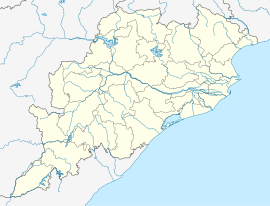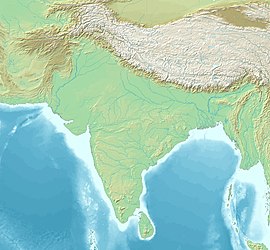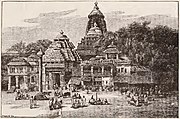
The Delhi Sultanate or the Sultanate of Delhi was a late medieval empire primarily based in Delhi that stretched over large parts of the Indian subcontinent, for 320 years (1206–1526). Following the invasion of South Asia by the Ghurid dynasty, five dynasties ruled over the Delhi Sultanate sequentially: the Mamluk dynasty (1206–1290), the Khalji dynasty (1290–1320), the Tughlaq dynasty (1320–1414), the Sayyid dynasty (1414–1451), and the Lodi dynasty (1451–1526). It covered large swaths of territory in modern-day India, Pakistan, and Bangladesh as well as some parts of southern Nepal.

Jagannatha is a deity worshipped in regional Hindu traditions in India as part of a triad along with his (Krishna's) brother Balabhadra, and sister, Subhadra. Jagannath, within Odia Hinduism, is the supreme god, Purushottama, and the Para Brahman. To most Vaishnava Hindus, particularly the Krishnaites, Jagannath is an abstract representation of Krishna, sometimes as the avatar of Vishnu. To some Shaiva and Shakta Hindus, he is a symmetry-filled tantric form of Bhairava, a fierce manifestation of Shiva associated with annihilation.

Sultan Firuz Shah Tughlaq was a Muslim ruler from the Tughlaq dynasty, who reigned over the Sultanate of Delhi from 1351 to 1388. He succeeded his cousin Muhammad bin Tughlaq following the latter's death at Thatta in Sindh, where Muhammad bin Tughlaq had gone in pursuit of Taghi the rebellious Muslim governor of Gujarat. For the first time in the history of the Sultanate, a situation was confronted wherein nobody was ready to accept the reins of power. With much difficulty, the camp followers convinced Firoz to accept the responsibility. In fact, Khwaja Jahan, the Wazir of Muhammad bin Tughlaq had placed a small boy on the throne claiming him to be the son of Muhammad bin Tughlaq, who meekly surrendered afterwards. Due to widespread unrest, his realm was much smaller than Muhammad's. Tughlaq was forced by rebellions to concede virtual independence to Bengal and other provinces. He established Sharia across his realm.
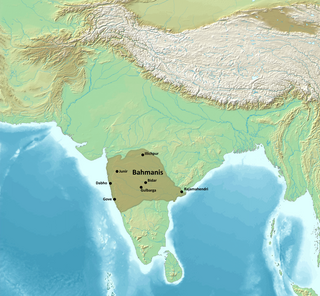
The Bahmani Sultanate was a late medieval empire that ruled the Deccan Plateau in India. The first independent Muslim kingdom of the Deccan, the Bahmani Sultanate came to power in 1347 during the rebellion of Ismail Mukh against Muhammad bin Tughlaq, the Sultan of the Tughlaq dynasty of Delhi. Ismail Mukh then abdicated in favour of Zafar Khan, who would establish the Bahmani Sultanate.

Muhammad bin Tughluq, also named Jauna Khan as Crown Prince, also known by his epithets, The Eccentric Prince, or The Mad Sultan, or The Wisest Fool was the eighteenth Sultan of Delhi. He reigned from February 1325 until his death in 1351. The sultan was the eldest son of Ghiyath al-Din Tughluq, founder of the Tughlaq dynasty. In 1321, the young Muhammad was sent by his father to the Deccan Plateau to fight a military campaign against the Kakatiya dynasty. In 1323, the future sultan successfully laid siege upon the Kakatiya capital in Warangal. This victory over King Prataparudra ended the Kakatiya dynasty.
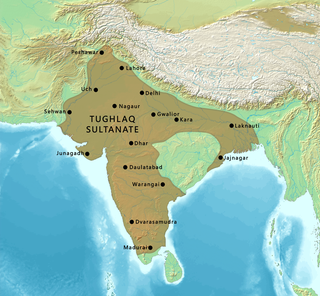
The Tughlaq dynasty was the third dynasty to rule over the Delhi sultanate in medieval India. Its reign started in 1320 in Delhi when Ghazi Malik assumed the throne under the title of Ghiyath al-Din Tughluq. The dynasty ended in 1413.

Sonargaon is a historic city in central Bangladesh. It corresponds to the Sonargaon Upazila of Narayanganj District in Dhaka Division.

Anangabhima Deva III was an Eastern Ganga monarch who ruled an early medieval Odisha centered empire in eastern India from the year 1211 CE to 1238 CE. He was successful in maintaining a large extent of territory that stretched from the river Ganga in the north to Godavari in the South. He had successfully defeated the Kalachuris on the western frontiers of the empire and established a matrimonial alliance with them. His brother or brother in law, Rajaraja II became the ruler of the Dynasty in 1198. When Anangabhima III came into power, in 1211, he expelled the Muslims of Bengal from his kingdom. He had a son, Narasingha Deva I, who would later invade Bengal in 1244, and captured the capital city, Gauda. He was a reformist in the social and spiritual structure of the Odia society as the vaishnavite deity Jagannath was declared as the supreme ruler of the empire and the emperor as the deputy under him. The Madala Panji records he claiming himself as Shri Purushottama dedicating everything to lord Jagannath. He built the famous Pradaskhina mandapa of Srikurmam temple.
The Gajapati Empire, was an empire established by the Suryavamsa dynasty or Routray dynasty, who were a medieval Hindu dynasty in the Indian subcontinent. It originated in the region of Trikalinga and reigned from 1434 to 1541 CE. It succeeded the reign of the Eastern Gangas. Under the Emperor Kapilendra Deva, the Gajapati empire stretched from lower Ganga in the north to Kaveri in the south.
Malik Maqbul, also referred to as Khan-i-Jahan Maqbul Tilangani and Jahan Khan) was an Indian commander in the Kakatiya Empire who was converted to Islam and rose to become the Wazir of the Delhi Sultanate under Firuz Shah Tughlaq. He was appointed as the governor of Hyderabad in service of the Delhi Sultanate and he ruled and governed all the lands of present day Telangana on behalf of the Delhi Sultanate.

Shamsuddin Ilyas Shah was the founder of the Sultanate of Bengal and its inaugural Ilyas Shahi dynasty. The Ilyas Shahi Dynasty ruled Bengal for 145 years (1342–1487), except for a 21-year interregnum by the descendants of Raja Ganesha. The Ilyas Shahi rulers are considered to be among the most important political, diplomatic and military leaders of Bengal during the sultanate period. In Bengali history, Ilyas Shah himself has been compared with Alexander the Great because of his ability to conquer large swathes of the Indian subcontinent. Ilyas Shah was instrumental in unifying the principalities of Bengal into a single state.

The Eastern Ganga dynasty were a large medieval era Indian royal Hindu dynasty that reigned from Kalinga from as early as the 5th century to the mid 20th century. Eastern Gangas ruled much of the modern region of Odisha in three different phases by the passage of time, known as Early Eastern Gangas (493–1077), Imperial Eastern Gangas (1077–1436) and Khemundi Gangas (1436–1947). They are known as "Eastern Gangas" to distinguish them from the Western Gangas who ruled over Karnataka. The territory ruled by the dynasty consisted of the whole of the modern-day Indian state of Odisha, as well as major parts of north Andhra Pradesh, parts of Chhattisgarh and some southern districts of West Bengal. Odia language got official status in their regime following the evolution of the language from Odra Prakrit. The early rulers of the dynasty ruled from Dantapuram; the capital was later moved to Kalinganagara, and ultimately to Kataka and then to Paralakhemundi.

The Bengal Sultanate was a late medieval sultanate based in the Bengal region between the 14th and 16th century. It was the dominant power of the Ganges-Brahmaputra Delta, with a network of mint towns spread across the region. The Bengal Sultanate had a circle of vassal states in the Indian subcontinent, including parts of Odisha in the southwest, Arakan in the southeast, and Tripura in the east.
Firouz, Pirouz, Feroz, Fayrouz, Phiroj, are masculine given names of Persian origin. It is ultimately derived from Middle Persian Pērōz, meaning "victorious, triumphant or prosperous", mentioned as Perozes (Περόζης) in Latin and Greek sources.
Feroz or variants such as Firuz, Firuze, Peroz or Piruz may refer to:
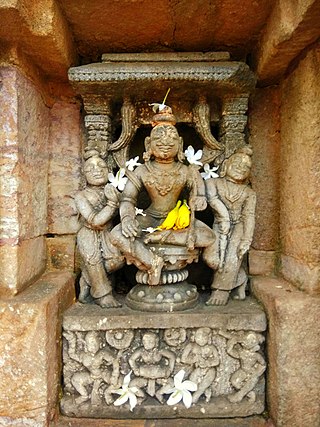
Kapilendra Deva was the founder of the Suryavamsa Gajapati Empire that ruled parts of eastern and southern India with the present-day Odisha as the center of the empire. He ascended to the throne after staging a military coup against the preceding and the last ruler from the Eastern Ganga dynasty, Bhanu Deva IV. He is also referred to as Kapilendra Routray or Sri Sri Kapilendra Deva. Kapilendra claimed descent from the Surya Vamsha of the Mahābhārata and was conferred the regnal title Shri Shri ...(108 times) Gajapati Gaudeshwara NabaKoti Karnata Kalabargeswara i.e. the Lord of Bengal (Gauda), the lord of the Karnataka region or Vijayanagara, the Lord of Kalaburagi and of nine crore subjects.

Prataparudra Deva was the third Gajapati emperor of Odisha from the Suryavamsa Gajapati Empire founded by his grandfather Kapilendra Deva Routaraya. He reigned from 1497 to 1540 CE. Besides being a monarch, he was a devout Vaishnava and adherent of the famous saint, Sri Chaitanaya who arrived in Odisha during his reign. His life was extremely occupied with overwhelming military campaigns in defense of his inherited territory from three frontal invasions by the enemy states Vijayanagar, Hussain Shahi dynasty of Bengal and Turko-Persian Qutb Shahi dynasty of Golconda. He lost large portions of his territory to the neighboring enemy states initiating the dissolution of Odisha's military hegemony and imperial status that continued for nearly a period of 600 years before him.

The Ekdala Wars were a series of long-lasting conflicts between the Bengal Sultanate and the Delhi Sultanate which took place in the islets of Ekdala in Bengal. The first invasion by the Delhi Sultanate resulted in the complete sack and occupation of Bengal capital Pandua by the Delhi army, before withdrawing and deciding not to annex Bengal. The Second invasion saw the Delhi armies advance to Ekdala again, but fail to capture the fort, culminating in a peace treaty where the Delhi Sultanate of India recognized the independence of the Bengal Sultanate.

The Bhoi dynasty or the Yaduvamsa dynasty were a medieval Hindu dynasty from the Indian subcontinent, which originated in the region of Odisha that reigned from 1541 to 1560 CE. Govinda Vidyadhara had usurped the throne from the later weaker Suryavamsa Gajapati Empire rulers as the kingdom started weakening but had a short-lived reign as ruling chiefs of Odisha as the ensuing internal rivalries and constant threats of invasions rendered them weak and were eventually overthrown by Mukunda Deva of Chalukya dynasty in 1560.
